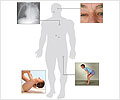Diagnosis
A diagnosis of
Tests for McArdle disease include:
Blood tests:
- Creatine kinase level: Elevated in more than ninety percent of patients with the disease
- Fasting blood glucose
- Urine analysis: Routine urine studies are performed. Myoglobinuria (described previously) is found in half of the patients after exercise.
- Liver function tests
- Biochemical assay is required for the definitive diagnosis of McArdle disease.
Ischemic forearm test:
Ischemic forearm test can be used to diagnose a number of muscle disorders. The test assesses the chemical reactions and products of muscle activity. In this test, forearm muscles are made to exercise after compromising the blood supply to the area. Blood levels (obtained from the area) of lactate and ammonia are measured before and after muscle activity (i.e. exercise). In McArdle disease, lactate levels fail to rise while ammonia levels show an exaggerated rise.
Electromyography
An
Muscle biopsy
Sample of muscle tissue is obtained and examined. Assay of muscle enzyme activity (to confirm the diagnosis) also requires muscle biopsy.
Gene testing for mutations may also be performed.









